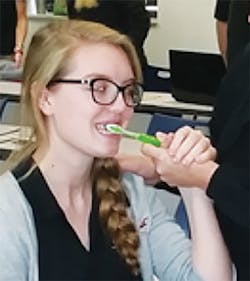At higher risk for oral disease, patients with Down syndrome require specialized oral care instruction
Taylor Swisher, BS, RDH; Haley Pryor BS, RDH, EFDA; and Daniel Schurman, BS, RDH
Down syndrome is an intellectual disability caused by changes in the DNA sequencing of chromosome 21. The World Health Organization estimates the worldwide incidence of Down syndrome to be approximately one in 1,000 live births.1 There are three types of Down syndrome. The most common type is trisomy 21, which occurs when there are three copies of chromosome 21 instead of two copies.1 The next type is translocation Down syndrome. Translocation Down syndrome occurs when an extra part of chromosome 21 breaks off and attaches, or translocates, to a different chromosome.1 This type accounts for a small percentage of people.1 Lastly, mosaic Down syndrome is a mixture or combination of the other two types.1 Individuals with mosaicism have three copies of chromosome 21 in some cells but not all.1 These individuals may have some but not all of the features of Down syndrome, due to the presence of some cells with the typical number of chromosomes.1
Individuals with Down syndrome may have physical features characteristic of the disorder. Some physical signs of Down syndrome include a small head; upward slanting eyes, often with a skin fold that comes from the upper eyelid and covers the inner corner of the eye; a flattened facial profile and nose; decreased or poor muscle tone; a short neck with excess skin at the back of the neck; white spots, called Brushfield spots, on the irises of the eyes; and wide, short hands with short fingers.2,3
Systemic signs of Down syndrome include congenital heart defects, premature aging, neuromuscular hypotonia, joint hyperextensibility or hyperflexibility, and many more.2 These physical and systemic signs are not only important to help identify a patient with Down syndrome, but also to determine which oral health modifications should be recommended for better health outcomes.
Some oral signs commonly found in those with Down syndrome include delayed eruption, small or congenitally missing teeth, macroglossia, malocclusion, and periodontal disease.2,3 Individuals with Down syndrome are less likely to develop carious lesions.4 Of those who have Down syndrome and are under the age of 30, 60% to 100% have periodontal disease.5 While no statistics are available, the rate of prevalence after age 30 is expected to be similar. This statistic is important to keep in mind. Dental professionals can provide early interventions to help reduce this periodontal statistic - not only for improved oral health, but also for improved systemic health. Individuals with Down syndrome are at a higher risk of developing periodontal disease because they have weaker immune systems and do not have some of the natural protections that people without Down syndrome have.6 This could be one of the factors leading to the development of periodontal disease in an individual with Down syndrome.
The next most prevalent oral sign of Down syndrome is malocclusion. This oral finding is present in 28% of those with Down syndrome.7 Class III malocclusion is the most common malalignment seen with Down syndrome.7 This classification is clinically noticed as mandibular protrusion, anterior open bite, posterior crossbite and lip incompetence, which often leads to mouth breathing.7 This dries the oral tissues, which in turn causes xerostomia, exacerbating periodontal disease. Orthodontic treatment can correct the class III malocclusion; however, proper oral care must be provided while orthodontic treatment is performed to prevent periodontal disease and caries.
It is important for dental providers to recognize these signs to administer optimal care for these patients. Dental providers should be aware of the oral complications that can affect patients’ systemic health. This information should be used to create a care plan that will allow the patient to be successful in maintaining a healthy oral cavity. Here’s an example to illustrate why this is important: xerostomia can develop from medications used to treat congenital heart defects, which may be present in those with Down syndrome. If the dental provider is unaware that a patient is taking one of these medications, xerostomia might not be addressed with the patient.6
Developing proper oral care habits can be challenging for patients with Down syndrome. Intellectual disabilities add another dimension to the likelihood of developing periodontal disease. Individuals with Down syndrome might not be able to understand or adequately complete the oral care recommendations made by dental providers.
Oral health education modifications
Many individuals with Down syndrome have both malocclusion and periodontal disease.8 Due to the higher risk of periodontal disease, the best way to stop its initiation and progression is to incorporate oral health education that is tailored to the patient’s needs and conditions. The approach used by many health-care professionals when working with patients who have Down syndrome is similar to that used while working with children.8 The caregiver might be required to assume responsibility for ensuring proper care at home.8 Including the patient’s caregiver during oral health education allows the caregiver to be aware of what the patient needs to be doing at home and make sure the patient is keeping up with oral care.
Another consideration when providing oral health education is to remove all distractions.9 Patients with Down syndrome might also enjoy step-by-step instructions on how to brush or use an oral care product properly.9 This can be done by using the tell-show-do approach: the clinician tells the patient what to do, shows the patient how to do the task, and then the patient does the task.10 After, the patient should be given a handout that illustrates the step-by-step instructions.10
Another technique to try is the hand-under-hand guidance technique (see Figure 1). Dexterity complications are common in individuals with Down syndrome,10 so this technique is a form of assisted self-care that can be used when patients are unable to brush independently.11 This technique can be used by the clinician when demonstrating proper brushing skills to help the patient understand how brushing should feel and look. A mirror is needed so the patient can watch. The clinician or caregiver places his or her hand on the toothbrush handle with the patient’s hand resting on top.11 Then the clinician or caregiver stands behind the patient while demonstrating the brushing technique.11 This should be shown to the caregiver, so it can be used at home to provide proper oral care if the patient needs assistance.
Next, if the patient struggles with a manual brush or cannot provide proper oral care because of dexterity issues, the clinician can recommend a powered toothbrush. This will allow for easier removal of plaque and better oral health.10 The large handle of a powered toothbrush makes it easier for the patient to grasp.10 If a powered toothbrush is not an option for the patient because of cost concerns, a tennis ball or stress ball can be slipped over the handle of a manual toothbrush to increase the handle diameter.10
If the patient is demonstrating good brushing technique and proper plaque control is noted, routine flossing can be recommended. A floss holder or floss picks can be used to help the patient have better control with the technique.11 To make it easier for the patient to obtain these interdental products, the office can stock these items to hand out or inform the patient or caregiver about where to purchase them.
Encourage the caregiver to make oral care fun for the patient. If the oral care experience is fun, the patient might be more interested in the tasks and more willing to complete the tasks each day.12 Brushing and flossing can be turned into a game and rewards can be given to the individual if oral care goals are reached.12 The same theory applies to oral health education in the dental office. If the patient keeps coming back to the office with decreased plaque and increased oral care, the office can give the patient a prize at the end of the appointment.
Dental providers should share statistics on the increased risk for developing periodontal disease for the Down syndrome population with the patient and caregiver.12 Awareness of the risk may be a driving force for prevention through proper oral care.
Patients with Down syndrome are at a higher risk for periodontal disease than the general population. Thus, periodontal disease prevention should be a primary focus for oral health education. This population requires dental providers to change the way they communicate and provide oral health education. Patients with Down syndrome learn best when minimal distractions are present, using the tell-show-do approach, practicing techniques with feedback from the practitioner, and leaving with handouts that show step-by-step instructions. The caregiver should be present in the operatory during the oral health education component of the appointment to reinforce techniques at home. The hand-under-hand guidance technique can be used during in-office demonstrations and again at home when the caregiver provides oral care. This will improve plaque removal and also help the patient feel independent.11 Finally, toothbrush handles should be modified if plaque removal is not adequate due to decreased dexterity.
Patients should schedule regular debridement appointments no further than four months apart, due to the higher risk of periodontal disease. If periodontitis occurs, the patient should receive treatment every three months. Be patient with these patients. Due to their special circumstances, it is important to modify care and communication. RDH
Acknowledgement
The authors would like to express their gratitude to their professor, Emily Holt, RDH, for her mentorship and editing.
Taylor Swisher, BS, RDH, is a recent dental hygiene graduate of the University of Southern Indiana (USI), currently practicing in Indiana. Swisher is a former member of the Optimist International Organization and has previously worked with people who have Down syndrome at The Arc of Evansville. Swisher can be reached at [email protected]
Haley Pryor, BS, RDH, EFDA, also a recent graduate of USI, practices dental hygiene in Tennessee. She worked with individuals with disabilities during her clinical internship as a certified nursing assistant in Indiana. She can be reached at [email protected].
Daniel Schurman, BS, RDH, received his bachelor’s degree in dental hygiene from USI and practices in Arizona. Schurman has been involved in several community health service learning projects that targeted communities with disabilities. He can be reached at [email protected].
References
1. Genes and human disease. World Health Organization website. http://www.who.int/genomics/public/geneticdiseases/en/index1.html. Accessed September 13, 2016.
2. Birth defects: Facts about Down syndrome. Centers for Disease Control and Prevention website. www.cdc.gov/ncbddd/birthdefects/DownSyndrome.html. Updated March 3, 2016. Accessed September 13, 2016.
3. What is different about the teeth of people with Down syndrome? National Down Syndrome Society website. http://www.ndss.org/Resources/Health-Care/Associated-Conditions/Dental-Issues-Down-Syndrome. Accessed September 24, 2016.
4. Moreira MJS, Schwertner C, Jardim JJ, Hashizume LN. Dental caries in individuals with Down syndrome: A systematic review. Int J Paediatr Dent. 2015;26(1):3-12.
5. Saxén L, Aula S, Westermarck T. Periodontal disease associated with Down’s syndrome: An orthopantomographic evaluation. J Periodontol. 1977;48(6):337-340.
6. Kamer AR, Fortea JO, Videla S, et al. Periodontal disease’s contribution to Alzheimer’s disease progression in Down syndrome. Alzheimer’s Dement (Amst). 2016;2:49-57.
7. Periodontal gum disease: Causes, symptoms, and treatments. National Institute of Dental and Craniofacial Research website. http://www.nidcr.nih.gov/oralhealth/Topics/GumDiseases/PeriodontalGumDisease.htm#gingivitis. Published September 2013. Updated December 8, 2014. Accessed September 24, 2016.
8. Pilcher E. Dental care for the patient with Down syndrome. Down Syndrome Education Online website. https://www.down-syndrome.org/reviews/84. Accessed on September 24, 2016.
9. Diéguez-Pérez M, de Nova-García MJ, Mourelle-Martínez MR, Bartolomé-Villar B. Oral health in children with physical (cerebral palsy) and intellectual (Down syndrome) disabilities: A systematic review. J Clin Exp Dent. 2016;8(3):e337-e343.
10. Anders PL, Davis EL. Oral health of patients with intellectual disabilities: A systematic review. Spec Care Dentist. 2010;30(3):110-117.
11. Practical oral care for people with Down syndrome. National Institute of Dental and Craniofacial Research website. https://www.nidcr.nih.gov/oralhealth/Topics/DevelopmentalDisabilities/PracticalOralCarePeopleDownSyndrome.htm. Updated November 3, 2014. Accessed September 26, 2016.
12. Hennequin M, Faulks D, Veyrune JL, Bourdiol P. Significance of oral health in persons with Down syndrome: A literature review. Dev Med Child Neurol. 1999;41(4):275-283.



